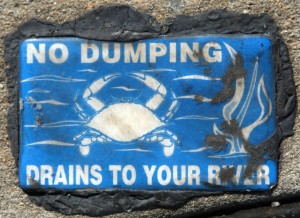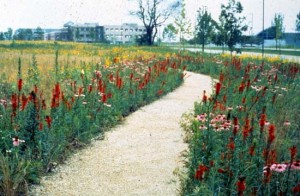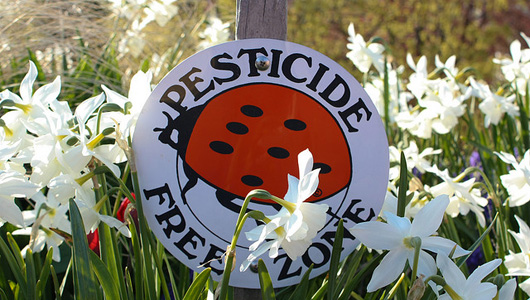Two important community issues involving water are the environmental dangers of lawns and the importance of storm drain stewardship.
Storm Drain Stewardship

What flows into storm drains doesn’t come only from roadway surfaces, though. Water runoff from buildings, walk and driveways and lawns washes into storm drains and watershed areas too and from them – right out into our rivers, streams lakes, estuaries and eventually, our oceans. The Milwaukee Riverkeeper defines watershed as, “…simply the area of land that catches rain and snow and drains or seeps into a marsh, stream, river, lake or groundwater.”
Lawn pesticides and fertilizers: A great health hazard
 The enormous quantity of pesticides and over-application of fertilizers on lawns makes them one of the great waterway – and therefor personal – health issues of our time. The Bayshore Regional Watershed Council has a 2007 newspaper article posted on its site cautioning about the health hazards of perfect lawns.
The enormous quantity of pesticides and over-application of fertilizers on lawns makes them one of the great waterway – and therefor personal – health issues of our time. The Bayshore Regional Watershed Council has a 2007 newspaper article posted on its site cautioning about the health hazards of perfect lawns.
The shimmering green of the finely groomed Long Island lawn may trigger an owner’s pride and neighborhood envy, but it also could pose a serious health risk … Karen Joy Miller, founder of the Huntington Breast Cancer Action Coalition, said pesticides are particularly dangerous for small children who are low to the ground, often barefoot and likely to put things in their mouths. Miller, a breast cancer survivor, said she suspects her sickness was caused in part by exposure to pesticides.

Of 30 commonly used lawn pesticides 19 have studies pointing toward carcinogens, 13 are linked with birth defects, 21 with reproductive effects, 15 with neurotoxicity, 26 with liver or kidney damage, 27 are sensitizers and/or irritants, and 11 have the potential to disrupt the endocrine (hormonal) system … A 2004 national survey reveals that 5 million homeowners use only organic lawn practices and products and 35 million people use both toxic and non-toxic materials.
Beyond Pesticides offers a toolkit for organizing your community against pesticides and tips for beginning to eliminate pesticides locally and offers this advice:
A growing body of evidence in scientific literature shows that pesticide exposure can adversely affect a child’s neurological, respiratory, immune, and endocrine system, even at low levels. Young children are particularly susceptible because of their rapid growth and decreased ability to detoxify toxins. Fortunately, there are proven safe, effective, and affordable ways to maintain attractive lawns and playable fields without the use of toxic pesticides.
The EPA also offers pesticide reduction tips. Their tips include recommendations to compost and use native plants.

Food supply is being threatened by bee death due to pesticides
Pesticides are dangerous for a number of environmental and health reasons which include the death of bees which society needs to pollinate and grow fruits and vegetables. For the first time this year in California, there were not enough bees on site to pollinate the entire crop of almonds. Weakened immune systems and outright death of bees is being attributed to overuse of pesticides and the reduction of open growth areas in favor of manicured lawns and unsustainably planned cities.
Fertilizers: another big health hazard and their partial ban in New Jersey
 Waterway health depends on the conservation of a delicately balanced ecosystem that must support aquatic plants, fish, seafood and insects as well as the watershed and beach areas surrounding them and the birds and wildlife they support. Over-fertilization of lawns with nitrogen and phosphorous has led to the destruction of waterway health around the country and in New Jersey, some of the nation’s toughest lawn fertilizer laws have been enacted. Rutgers University summarizes the laws in this FAQ. An nj.com article summarizes the reasons behind the laws.
Waterway health depends on the conservation of a delicately balanced ecosystem that must support aquatic plants, fish, seafood and insects as well as the watershed and beach areas surrounding them and the birds and wildlife they support. Over-fertilization of lawns with nitrogen and phosphorous has led to the destruction of waterway health around the country and in New Jersey, some of the nation’s toughest lawn fertilizer laws have been enacted. Rutgers University summarizes the laws in this FAQ. An nj.com article summarizes the reasons behind the laws.
Nitrogen and phosphorus, while important for plant growth, are harmful to the environment if they wind up in the water. Nitrogen is a greater threat to coastal water, while phosphorous is more harmful in fresh water. Nitrogen causes algae blooms that deprive water of oxygen and kill marine life, and in New Jersey, environmentalists and scientists said that nitrogen was the primary reason for the slow death of salt water bodies, especially the Barnegat Bay.
Fertilizers in New Jersey may no longer contain phosphorus, except in special circumstances when a soil test indicates need, or when establishing or re-establishing turf …
